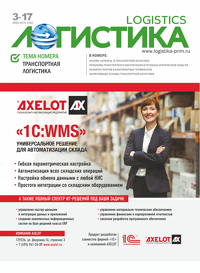Scientific & Practical Journal

Editorial News
Dear readers! We are pleased to present to you the eleventh issue of the journal in 2025. There are a lot of relevant and useful materials in the issue, which, hopefully, will not be ignored.
Dear readers! In September the CeMAT RUSSIA exhibition was held, which showed everyone that innovations and robotics are increasingly penetrating the logistics industry. We can safely say that many technologies are tested here, and only then they go out into the world. However, it is not only CeMAT RUSSIA that demonstrates the prevalence of the digital agenda.
Dear readers! This is the ninth issue of the journal, which turned out to be very rich and diverse. Traditionally, the issue is opened by an analyst. The material by Alina Nasyrova from the Market Guide Agency, dedicated to investments in warehouse complexes in Russia, recalls the importance of developing logistics infrastructure for the integrated development of regions.
PHOTO OF THE WEEK
CITATIONS
«Logistics» Journal № 3 / 2017
EVENTS
You are welcome to visit for free the largest exhibition of transport and logistics services in Russia ‒ TransRussia/TransLogistica 2017
MARKET ANALYSIS
"Logistics Development in Russia: Current Situation, Forecast, Key Challenges and Priorities of Companies" – research findings
INFRASTRUCTURE
Port of Sabetta ‒ infrastructure project in the Russian Arctic
The article discusses the possibility of development and improvement of the transport infrastructure of the Arctic territories of Russia, in particular the Northern Sea Route (NSR), which has the potential to become an alternative to the existing intercontinental transport links between the countries of the Atlantic and Pacific basins. Being a natural integrating element of the whole Arctic, SMEs in their development should be based on a system of Arctic sea ports. Particular attention is paid to the seaport Sabetta (major infrastructure component "Yamal LNG" project).
Key words. Arctic transport system of the Russian Federation, the Northern Sea Route, transport infrastructure, seaport Sabetta, Novatek, Yamal, Northern latitudinal, integrated railway infrastructure, Arctic sea transport corridor.
The article considers by steps evolution of handling of general cargo in marine ports, beginning from usual separate handling of packaged piece cargoes to complex handling of containers. Nominal throughput capacity of each port element at each step of evolution and influence of capacity of separate element to whole port capacity are shown. Number of operations, which make sense to be put out of port at present stage of port development, is distinguished. Considered influence of some operations to port warehouse functioning and it’s throughput. Also role of information technologies in operation of advanced container terminal is underlined and described. Formula, substantiating usage of dry ports in marine container flows handling, is offered.
Key words. Container terminal, throughput capacity, out port terminal, dry ports, analyses, substantiating.
TRANSPORT. TRANSPORTATION
Transport Provision Problems in the Arctic Regions of the Russian Federation
Brief up to date characteristics of Arctic transport system is presented, the most hot problems of transport provision in the Arctic regions of Russian Federation are determined, possible ways of improving the present situation are named.
Key words. Arctic, Northern Sea Route, transport provision, GDP (gross domestic product).
LOGISTICS SERVICE
What do logistics operators outsource?
The article explores outsourcing in logistics market. Commercial companies frequently outsource logistics to specialized companies. At the same time, logistic companies themselves often opt for outsourcing, because it is not reasonable to own all the logistical assets. The article answers the question: what logistic companies do themselves, and what they outsource, and which way of doing business is more sustainable. The study will be of interest to top and middle management, researchers of economics, logistics and outsourcing.
Key words. Outsourcing, logistics, logistics operators, railroad, maritime, automobile cargo companies, competitive advantage.
PROBLEMS AND OPINIONS
Normative frameworks of transport logistics: basic and sectoral levels of regulation
The present article considers the phenomenon transport logistics from the perspective of normative analysis. The legal acts, constituting the basis of transport logistics, are structurally grouped and briefly described. The separate articles of the relating legislation are given as the examples. The availability of basic and sectoral binding rules that shape the normative environment of transport logistics is shown. In conclusion, the hypothesis on the formation of the «logistic law» is formed.
Key words. Logistics, transport logistics, legal frameworks, legal acts, regulation, formalization.
Comments on the article by Oleg Volodin "Normative framework of transport logistics: basics and sectoral levels of regulation"
The design of logistics chain is strategically important issue for almost every company. There is a large variety of model formulations and solving algorithms, which vary in fundamental assumption, mathematical complexity, etc. In this paper classification of models of dislocation of logistic capacities is considered and the multicriteria model of optimum dislocation of warehouses in supply chains is offered.
Key words. Facility location, logistics networks, mathematical modelling, optimum dislocation of warehouses.














